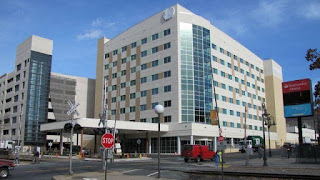by Steve Reinbrecht
To have a vibrant city downtown, full of fun things to do, people
need to enjoy walking along the blocks.
Long stretches of bare walls with no detail or windows is a
big turn-off for pedestrians, urban planners agree.
That pretty much describes too many blocks along Penn Street,
in Reading. Poor leadership has lead to poor design of rare downtown development, another burden for Berks
County’ seat to surmount.
Major buildings have been plopped down over the past 10 years
where they could be, with no planning. The result is that few guests who visit
the new hotel will ever walk to the GoggleWorks, the fantastic art center just
five blocks away.
The Santander bank building, the Reading Eagle Company’s
press building, the hockey arena, and now the hotel are examples of featureless
facades that would discourage the most vigorous urban explorer to see what’s on
the next block.
Lancaster has had an urban-renewal plan – and has followed
it – for 10 years, with great results.
A letter-to-the-editor Thursday in the Reading Eagle eloquently raises the concerns. After praising retail-magnate Al Boscov's “savvy and
determination to get it built,” Fred Opalinski writes:
“I'm appalled at the forbidding, prisonlike exterior, to my
mind the worst of urban design left over from the architecturally horrific
1960s. My wife and I have traveled extensively, and I can't think of an urban
hotel anywhere in the world with two blocks of unbroken concrete wall. It's a
loud and clear ‘KEEP OUT!’ (Or, just as bad, it says to the clients, ‘We'll
keep you safe from the city.’)
“Across the tracks from the cold and hard design of earlier
renovation mishaps, I was hoping for gardens, shops and plenty of hotel/city
interaction. It could have been so beautiful. Instead we have a bleak and
massive bunker without a hint of green space.
“With all the talk of wanting to be more like Lancaster and
other successful downtowns, I don't know how the planning commission could have
approved this design. Sixty-three million dollars could and should have given
us so much more.”
“Charleston Mayor Joe Riley reminds us that cities should be
places that make the heart sing. For many of our citizens, especially those too
poor or infirm to travel, the city is an entire world. For this reason, it is
our responsibility to create and maintain cities that not only function
properly, but also afford moments of beauty.
“Yet how many communities today routinely award to the
lowest bidder their contracts for schools, parks, and government buildings, the
only investments that belong to us all? In the interest of short-term parsimony,
we cheat ourselves out of an honorable public realm and a noble legacy.
“This did not use to be the case, and it need not continue.
Many of the nation's most beautiful buildings and parks were built during
periods of unparalleled adversity. It should not take another depression to
make civic structures lovely again.
In New York, a study showed, the average proportion of the
ground floor covered in windows significantly related to pedestrian traffic, “even
after controlling for the presence of retailers on the ground floor—meaning the
appeal likely goes beyond window-shopping.”
“The transparency of store fronts and show windows serve to
engage with pedestrians and provide them with a sense of safety and security.
Furthering the feeling offered by these uses is the glow at night from open
stores spilling out into the sidewalk, a large improvement when compared to
shuttered stores or blank walls.
“Urbanist Jane Jacobs noted this correlation between ground
floor activity and vitality, and how this activity could passively reduce crime
simply by having more ‘eyes on the street.’ Such design measures have been
shown to significantly deter crime.”




Duble tree does look like a self segregated block of Reading.
ReplyDelete